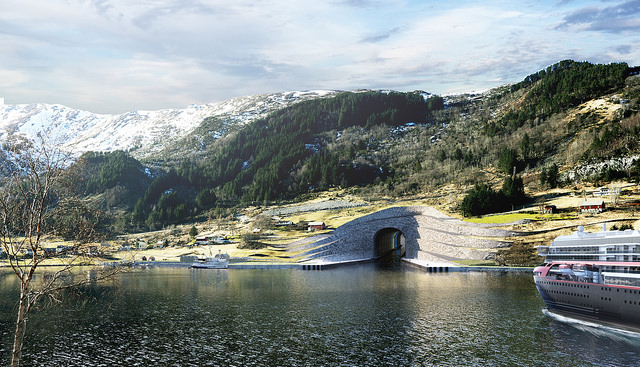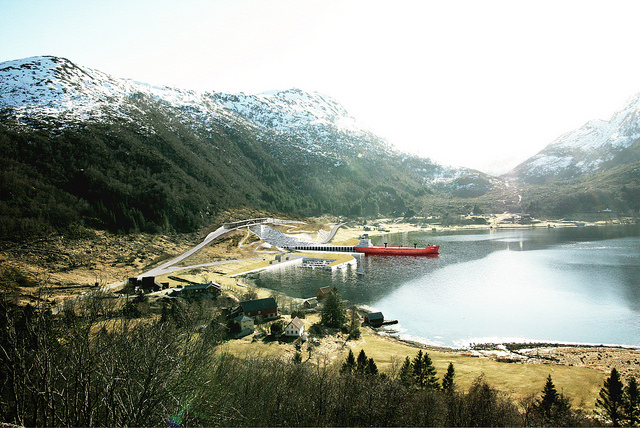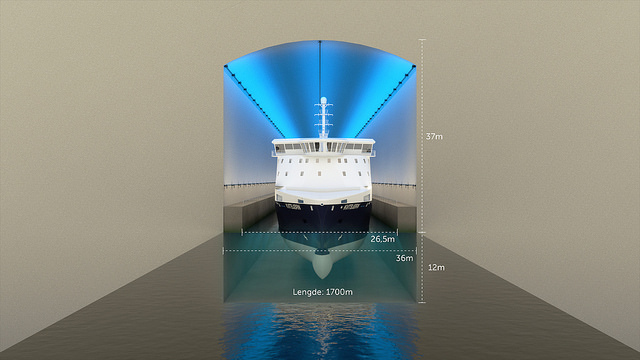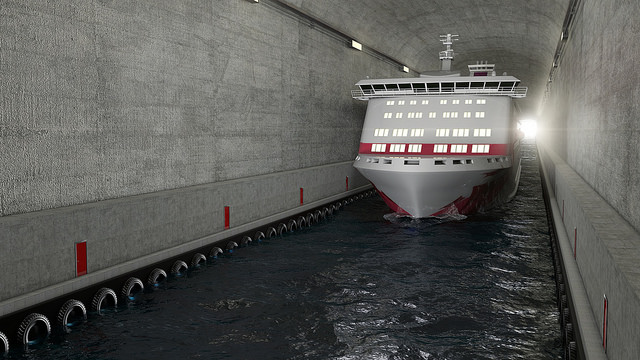Stad Ship Tunnel
In April 2017, plans were given the go-ahead for the Stad Ship Tunnel in Norway; the first of its kind in the world. The project is part of the Norwegian National Transport Plan 2018-2029, smoothing the way for the Norwegian Coastal Administration (NCA) to begin development work.
The Stad sea is the most exposed and dangerous part of the coast of Norway. Particularly complex and unpredictable navigational conditions are created by the combination of currents and subsea topography. This causes very high multi-directional waves, which can continue for several days after heavy wind has abated.
It is anticipated that the tunnel will reduce the risk of accidents, strengthening the region’s industrial and commercial activities, and making the voyage safer for passengers and freight.
Studies conducted in 2000/01 and 2007/08 analysed a range of cross-sections and routes for the tunnel. The final design crosses the narrowest point of the Stad Peninsula, with waters that are sufficiently shielded to allow shipping to use the tunnel.
The tunnel will be 1.7 km long, 37 m high and 26.5 m wide. The tunnel’s upper part will be run as per conventional road tunnel. Once that is complete, construction will progress downwards, layer by layer, in a process known as pallet blasting. Thresholds will be placed at both ends of the tunnel to enable dry tunnel operations.
In total, approximately 3 million cubic metres of rock will be removed by vehicles and large barges. There is a plan to establish a new landmass and expand existing areas of neighbouring municipalities with some of the removed material.
The estimated cost of the project is NOK 2.7 billion. There are optimistic predictions that the tunnel could be complete and open for shipping by early-2023. However, the project must first undergo a process of quality assurance and detailed cost estimates before being presented to the Norwegian parliament to approve funding. With parliamentary approval, construction work could begin in 2019.
Images and content courtesy Norwegian Coastal Administration.
[edit] Find out more
[edit] Related articles on Designing Buildings Wiki
Featured articles and news
RTPI leader to become new CIOB Chief Executive Officer
Dr Victoria Hills MRTPI, FICE to take over after Caroline Gumble’s departure.
Social and affordable housing, a long term plan for delivery
The “Delivering a Decade of Renewal for Social and Affordable Housing” strategy sets out future path.
A change to adoptive architecture
Effects of global weather warming on architectural detailing, material choice and human interaction.
The proposed publicly owned and backed subsidiary of Homes England, to facilitate new homes.
How big is the problem and what can we do to mitigate the effects?
Overheating guidance and tools for building designers
A number of cool guides to help with the heat.
The UK's Modern Industrial Strategy: A 10 year plan
Previous consultation criticism, current key elements and general support with some persisting reservations.
Building Safety Regulator reforms
New roles, new staff and a new fast track service pave the way for a single construction regulator.
Architectural Technologist CPDs and Communications
CIAT CPD… and how you can do it!
Cooling centres and cool spaces
Managing extreme heat in cities by directing the public to places for heat stress relief and water sources.
Winter gardens: A brief history and warm variations
Extending the season with glass in different forms and terms.
Restoring Great Yarmouth's Winter Gardens
Transforming one of the least sustainable constructions imaginable.
Construction Skills Mission Board launch sector drive
Newly formed government and industry collaboration set strategy for recruiting an additional 100,000 construction workers a year.
New Architects Code comes into effect in September 2025
ARB Architects Code of Conduct and Practice available with ongoing consultation regarding guidance.
Welsh Skills Body (Medr) launches ambitious plan
The new skills body brings together funding and regulation of tertiary education and research for the devolved nation.
Paul Gandy FCIOB announced as next CIOB President
Former Tilbury Douglas CEO takes helm.
UK Infrastructure: A 10 Year Strategy. In brief with reactions
With the National Infrastructure and Service Transformation Authority (NISTA).


























